Index
- EVGA GTX 770 Superclocked ACX 2GB reviewed
- The Packaging
- A closer look at the ACX cooler
- A closer look at GTX 770 SC ACX continued
- Testbed
- 3DMark
- Hitman Absolution
- Sleeping Dogs
- Tomb Raider
- Dirt Showdown
- BioShock Infinite
- Tessellation - Heaven
- Thermals and Noise
- Overclocking
- Consumption
- Conclusion
- All Pages

Review: ACX pushes it over the top
After EVGA successfully rolled out the GTX 780 Superclocked with the ACX cooler, two new ACX coolers entered the fray, on the GTX 770 and GTX 760. Today we’ll take a look at one of them, the GTX 770 Superclocked ACX.
Based on the GTX 770 design paired up with a custom cooling solution, the new EVGA GTX 770 Superclocked ACX graphics card is factory overclocked, as the name implies. The base clock is set at 1111MHz, while the reference GPU base clock is 1046MHz. Additionally, Nvidia's GPU Boost 2.0 on average ups the GPU clock to 1085MHz for the reference GPU, while the Boost clock for the Superclocked card is 1163MHz.
Since the GTX 770 appears to have hit the price/performance sweet spot for many hard core gamers, EVGA came up with no fewer than ten different SKUs – and who could blame them? Nvidia also made it possible for partners to come up with custom cards with 4GB of GDDR5 memory. Our review sample the GTX 770 Superclocked ACX features 2GB of GDDR5 memory on a 256-bit memory interface and clocked at reference 7010MHz (GDDR5 effective).
For the first time we see Nvidia going for such fast memory modules, which should go a long way towards boosting performance. The peak memory bandwidth stands at 224.3GB/sec – that’s 15 percent more bandwidth than last year’s Geforce GTX 680.
The GTX 770 is based on the GK104 GPU. We already had a chance to meet it last year, in the GTX 680. Both cards have 1536 CUDA cores, 128 texture units and 32 ROPs so the “new” generation doesn’t really bring a lot of new stuff to talk about. As we said, the GTX 680 has slower memory (6008MHz effective GDDR5) and its GPU clock is 1006GHz, while the boost clock is 1058MHz. However the GTX 770 can draw as much as 230W of power, whereas the GTX 680 needs just 195W.
Judging by the specs, it is obvious that the performance difference can’t be very big and but we’re hoping that the factory overclock of the GTX 770 Superclocked ACX will make the difference more visible.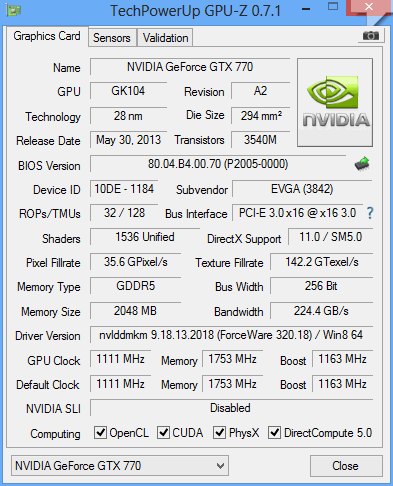
In the box you’ll find:
User Guide
Quick Installation Guide
Driver DVD
A small note about PCIE 3 compatibility
A new sticker set (Enthusiast Built)
EVGA Full Size Poster
EVGA Case Badge
DVI to VGA Dongle
1x Molex to 6-pin Power Adapter
1x Molex to 8-pin Power Adapter

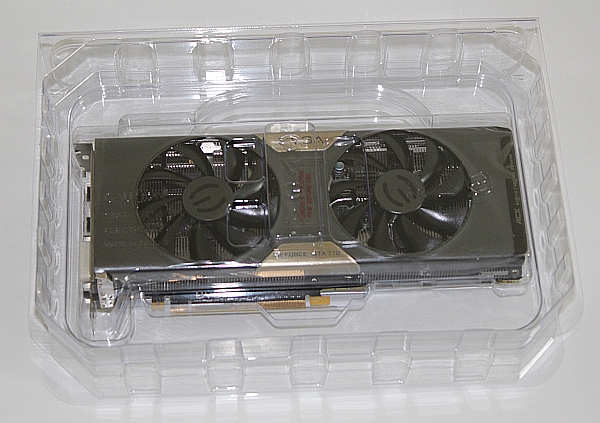

EVGA is constantly working to improve its custom components and come up with cards capable of trumping the competition. Even in its reference form, the GTX 770 is a top notch card with a great cooler and Nvidia partners really needed to get creative this time around. As a result, EVGA’s GTX 770 Superclocked uses the ACX (Active Cooling Xtreme) cooler which we already had a chance to try out on earlier cards, including the GTX 780 Superclocked ACX. The new ACX cooler impressed us both in terms of performance and low noise.
Before we proceed, let’s see how it looks. It is a dual-slot, dual-fan design and it looks like it means business.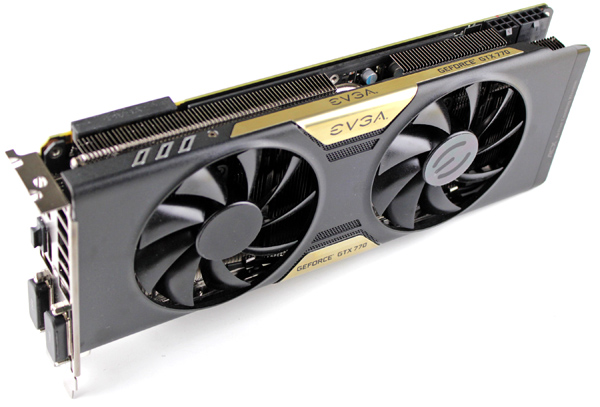
High-end graphics cards generate plenty of heat and many AIB partners resort to massive triple-slot coolers to reduce noise and allow higher clocks, while keeping the GPU under the thermal threshold. With the ACX cooler EVGA took things to the next level, as the reference cooler was tough to improve upon. Since it is a dual-slot design, it is also perfect for enthusiasts who plan to use the card in three-way or four-way SLI setups.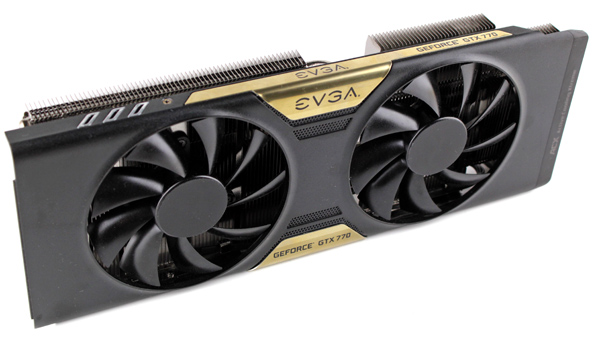
EVGA designed a special heatsink with a lot of dissipation surfaces. The heatsink was designed in such a way to minimize airflow turbulence between the fans, with clever barriers directing the airflow.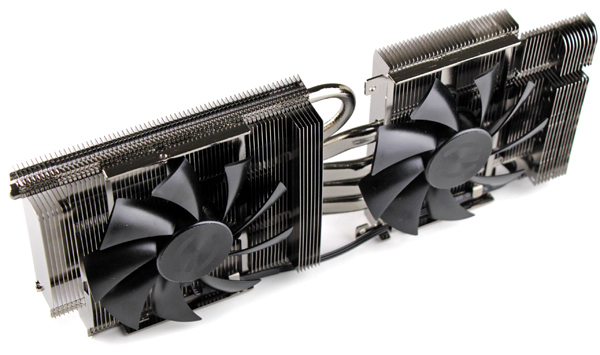
To maximize dissipation volume, EVGA used a few tricks, such as tall fins at the sides of the cooler. Airflow channels provide better airflow and prevent pockets of hot air from creating inside the heatsink and they should be kept clean.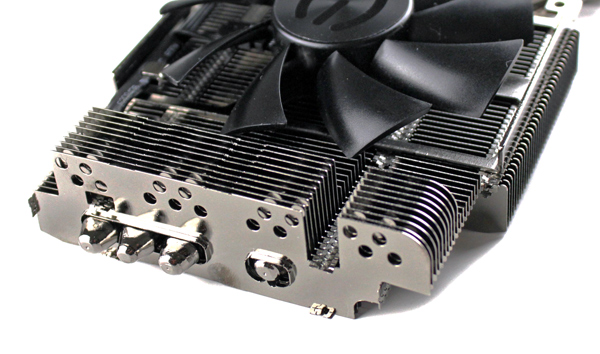
The ACX cooler comes with five elaborate heatpipes.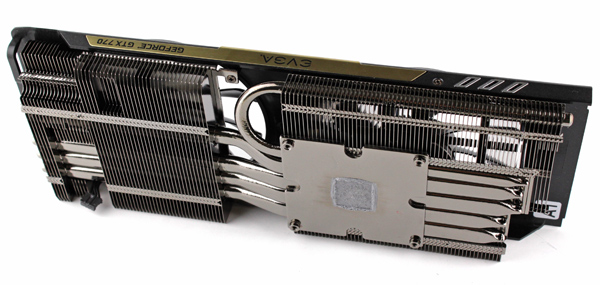

The Power Logic PLA09215B12H fan has some good features. First of all it was chosen due to its dense, curved blade design and double ball bearing design.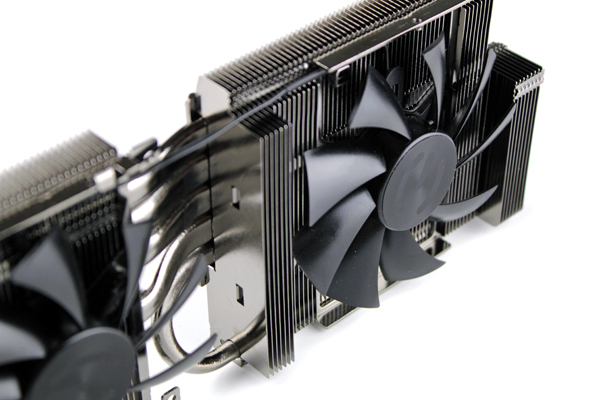
A poor blade design generates more noise but, this particular 9-blade fan seems to be up to the job. EVGA says that the blades are up to 700% more rigid than fan blades used in competing fans, which also results in a 25% weight reduction. We can report that the blades feel very strong indeed.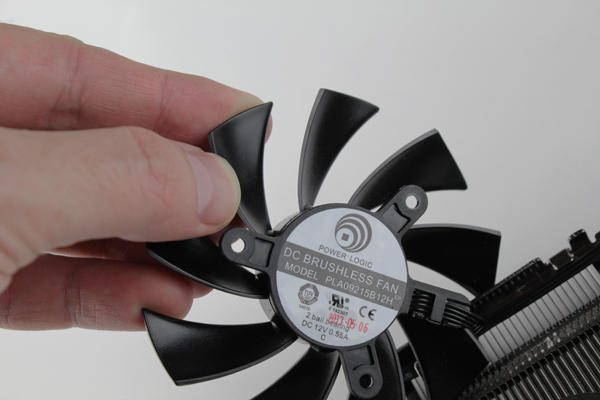
The fan uses a double ball bearing design. The noise generated by ball bearing designs tends to be very low, at least while they are new. However, since this fan uses two ball bearings it should last a bit longer and generate a less noise even after a couple of years of wear.
This is what the bearings look like in real life, opposed to standard sleeve bearings used in most fans. 
The GTX 770 Superclocked ACX cooler is 27cm or just under 11 inches long and sports a dual-slot, dual-fan cooler design.
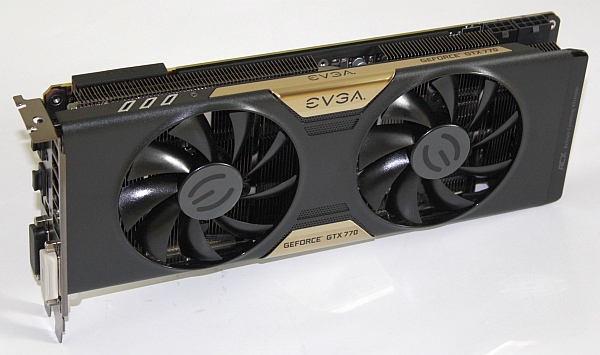
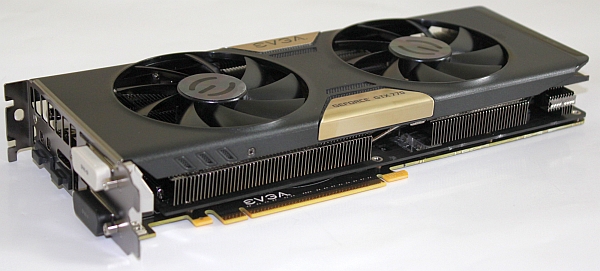
A combination of 6-pin and 8-pin power connectors is necessary to keep the show going.
The GTX 770 Superclocked PCB looks a lot like the reference GTX 770 board. EVGA decided to reinforce the baseplate to strengthen the PCB and provide a bit more cooling to the memory chips and MOSFET.
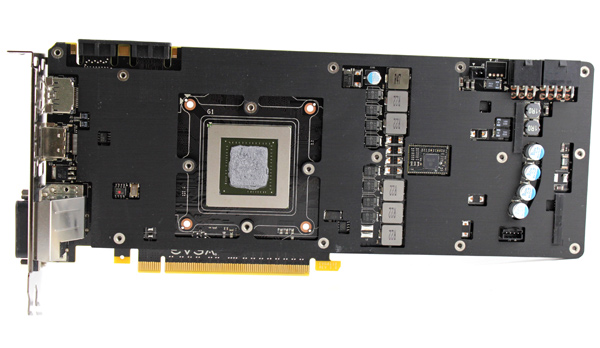
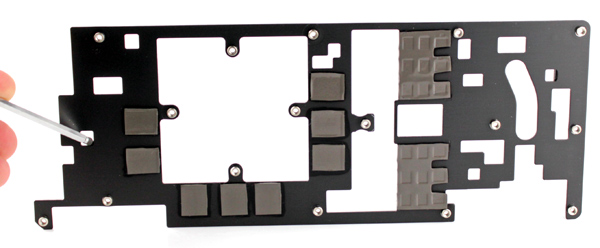
The card uses an OnSemi NCP4206 voltage controller.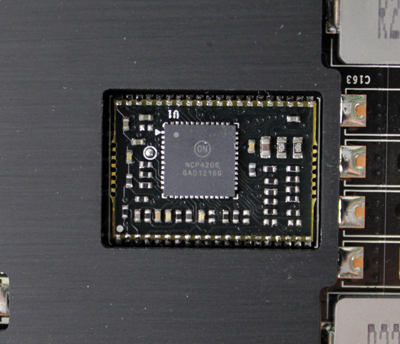
The card has 2GB of GDDR5 memory. The Samsung chips, (model K4G20325FD-FC28) are specified to run at 1750 MHz (7000 MHz GDDR5 effective). All the memory modules at the front of the PCB are underneath the reinforcement plate.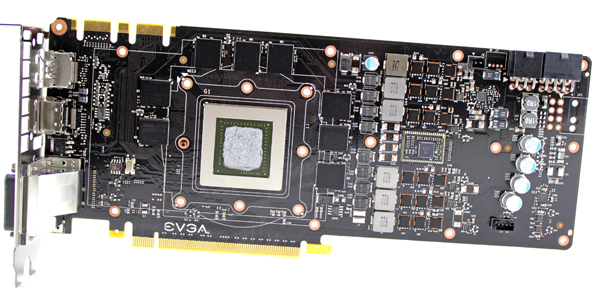
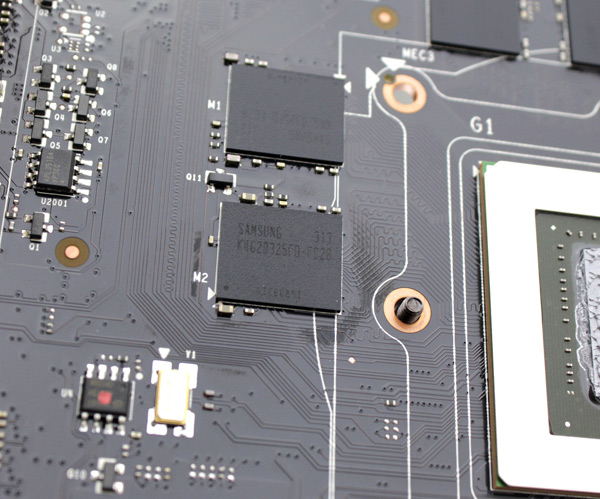
The GTX 770 Superclocked ACX features one standard HDMI connector (1.4a compatible), one standard DisplayPort out and two dual-link DVI outs.

The GTX Superclocked 770 is ready for multi-GPU action, be it in standard two-card SLI, or 3-way and 4-way SLI. Therefore it features two SLI connectors.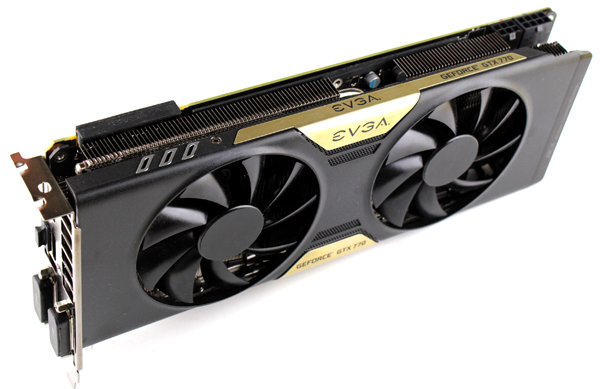

Testbed:
- Motherboard: EVGA Z77 FTW
- CPU: Ivy Bridge Core i7 3770 (4.5GHz)
- CPU Cooler: Gelid The Black Edition
- Memory: 8GB Corsair DDR3 2400MHz
- Harddisk: Corsair Neutron GTX 240GB
- Power Supply: CoolerMaster Silent Pro 1000W
- Case: CoolerMaster Cosmos II Ultra Tower
- Operating System: Win8 64-bit
Drivers:
- Nvidia 326.80 Beta
- AMD 13.8_Beta

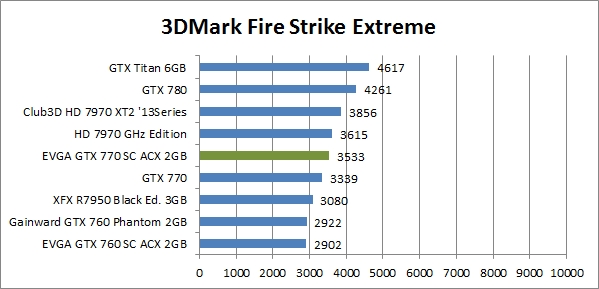

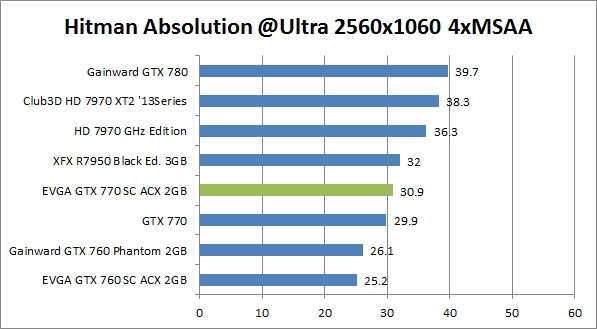
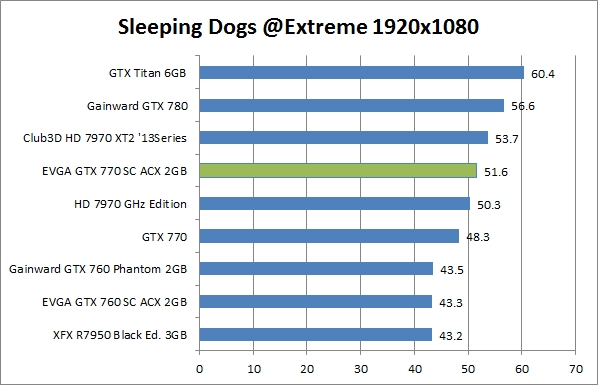
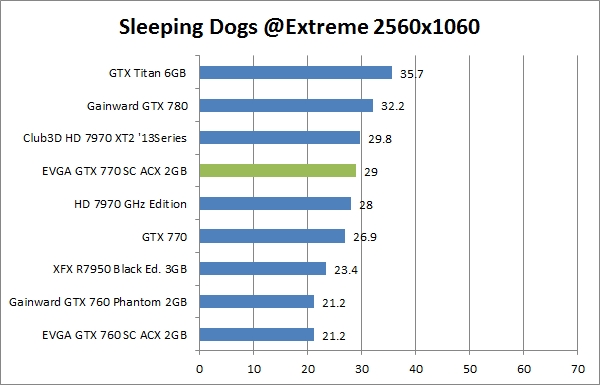

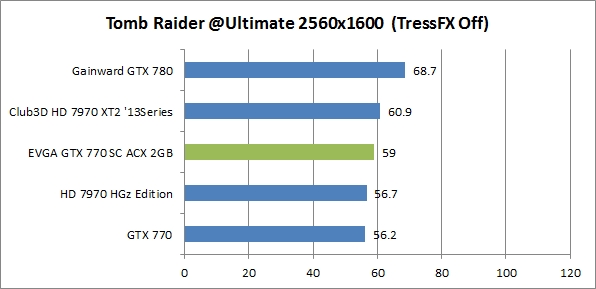
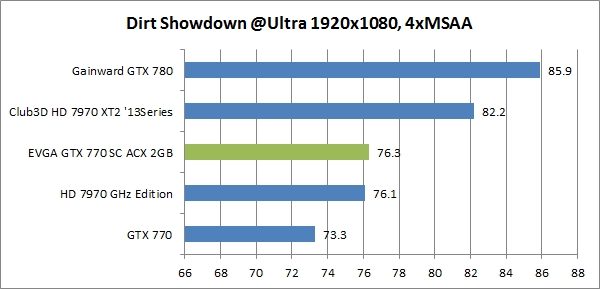
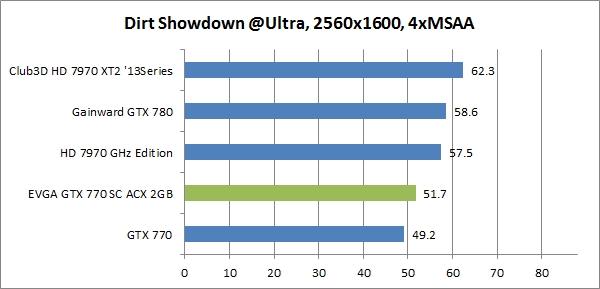
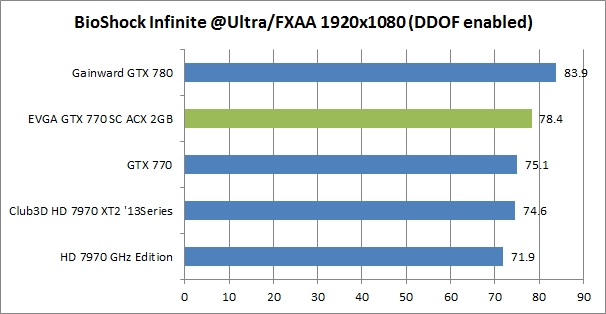
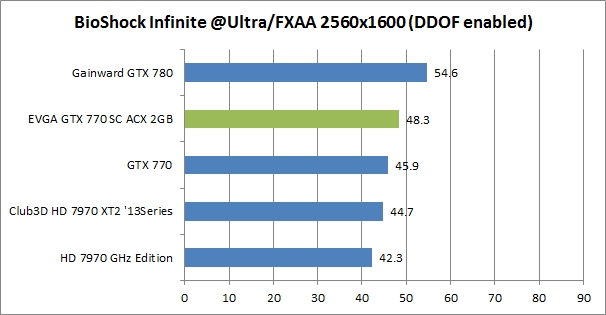
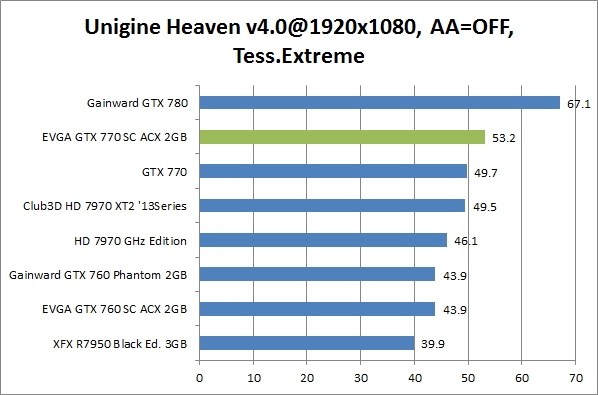
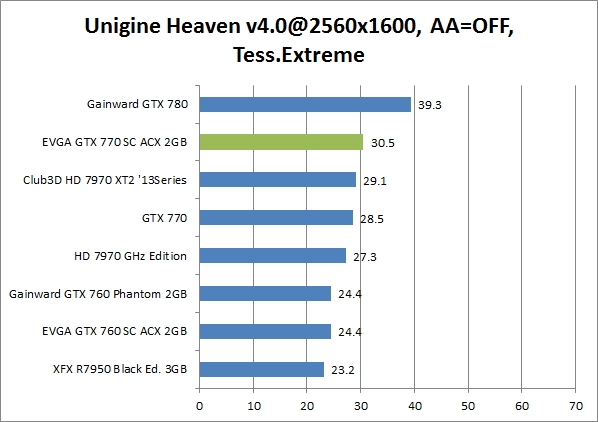
A very important feature of both GTX 780 and GTX 770 is improved cooling and new thermal control. The new Boost 2.0 algorithm will reduce the GPU clock if the temperature goes over 80 degrees.
Nvidia’s reference cooler for the GTX 780 and GTX 770 was borrowed from the GTX Titan and it perfectly fits the cooling requirements of the Boost 2.0 algorithm. The ACX cooler is quiet, even under load. It’s not inaudible, of course, but it won’t be a distraction during a gaming session. The card is completely silent in idle.
The EVGA ACX cooler is superior to the reference design as it keeps the GPU temperatures below 70 degrees, which is 10 degrees or 14 percent better than the reference unit. If the ACX cooler wasn’t as good, GPU Boost 2.0 would kick in and throttle the card once it gets too hot for comfort.
During our Unigine Heaven test at 1080p, with extreme tessellation settings, the GPU hit 64 degrees Celsius. In the same test a reference GTX 770 hits 79 degrees. In Crysis 3, at 2560x1600 and very high details, the GTX 770 SC ACX heats up to 69 degrees, while the reference card hits 79 degrees.
The overclocking potential is good but board power limitations prevent this card to use full cooling potential of ACX cooler. However the cooler is now more important than ever, due to Boost 2.0 throttling and dynamic thermal management. We managed to push the GPU 75MHz over the factory clocks and let’s not forget that this is a factory overclocked card. We upped the mamory clock from 7012MHz to 7500MHz. 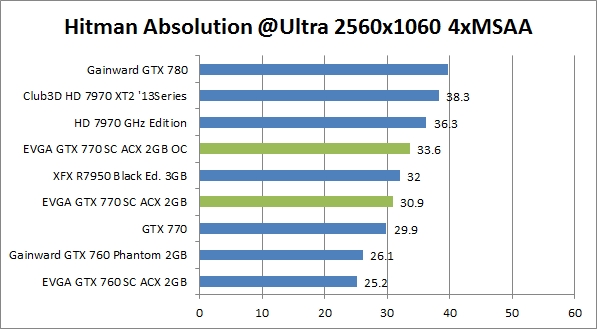
In our power consumption tests the GTX 770 SC ACX used only slightly more juice than the reference GTX 770, but this is quite normal for an overclocked card. Overall, performance-per-watt is good and it is better than for the HD 7970 GHz Edition.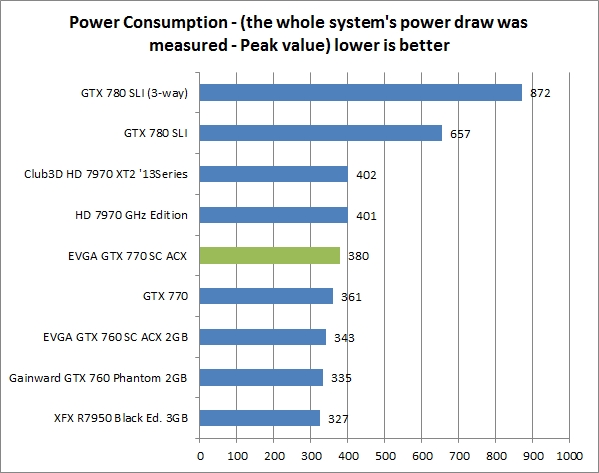
EVGA has done an excellent job yet again. Coming up with a cooler that copes so well with an overclocked GPU wasn’t easy, but EVGA pulled it off with flying colors. It managed to hit the sweet spot, as the ACX cooler does a better cooling than the reference design, while at the same time generating same noise. The ACX cooler is a great alternative to the reference Titan-derived cooler. It is not silent under load, but it is so quiet that you can barely hear it outside the chassis.
As usual, Superclocked cards ship with a nice factory overclock and the GTX 770 Superclocked is no exception. It is clocked 65MHz higher than the reference card and it is up to 6 percent faster. The GTX 770 SC ACX does not run out of steam at 2560x1600 resolution either, depending on the level of eye candy.
The GTX 770 has 2GB of GDDR5 and unless you have some very specific requirements, 2GB should be enough for comfortable gaming. For those who strive for more there’s another SKU with 4GB of GDDR5 memory. Most users, however, probably don’t need the extra 2GB of memory.
The Geforce GTX 770 is part of Nvidia’s new 700-series, but it bears more than a passing resemblance the GTX 680. The GTX 780 is a different beast and it is in a different league. Nvidia says the GTX 770 card is supposed to replace the GTX 670 rather than the GTX 680, so users of 670/680 cards aren’t the ones Nvidia is going after. The GTX 770 is ideal as an upgrade for the 500-series or similar Radeon cards. The GTX 770 is 65 percent faster than the GTX 570, making it a good replacement for the GTX 570. GTX 770 boasts a twofold increase in performance per watt compared to the GTX 570 and it also support four external displays simultaneously rather than just two.
As we all know, new GPU generations tend to end up more expensive than their predecessors, just look at new GTX 780 and GTX Titan, €650 and €990 price respectively. This is a trend we’ve been witnessing for years and it’s not good for PC gaming as a whole. The PC market is on life support, yet Nvidia and AMD are still jacking up GPU prices like there’s no tomorrow. Luckily the GTX 770 was launched with a €399 price tag and it’s already available for as little as €340.
The EVGA 770 Superclocked is priced starting at €354 and it is not much of a price difference in this segment, all things considered. We believe the ACX cooler is worth the extra 10 to 20 euro.



